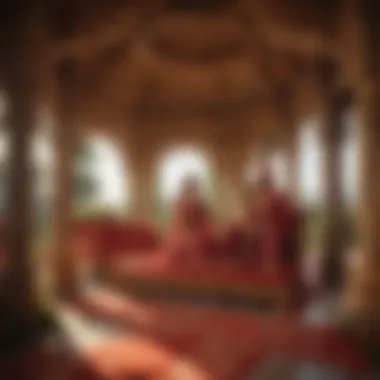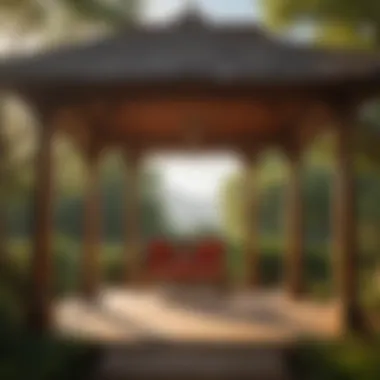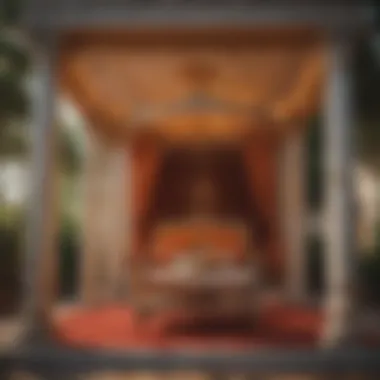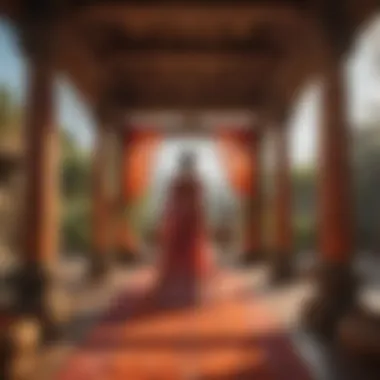The Indian Wedding Mandap: Significance and Design


Intro
The Indian wedding mandap stands as a crucial element in the landscape of traditional Indian marriages. This structure transcends mere aesthetics; it embodies the sacred space where the union of two individuals takes place. Understanding its significance offers a window into the cultural fabric of India. The article delves into the historical importance, architectural features, cultural meanings, and evolving designs of the mandap, reflecting contemporary trends in matrimonial ceremonies. By examining the role of the mandap across various Indian cultures, we extract valuable insights essential for anyone seeking to grasp its deeper meanings.
Historical Context
The roots of the mandap can be traced back to ancient Vedic rituals. Originally, it served as a temporary structure for religious ceremonies, offering a space that separated the sanctum from the external world. The rituals performed under the mandap are often deeply symbolic, celebrating the divine union between partners.
Over centuries, the design and construction of mandaps have evolved, influenced by regional practices and cultural exchanges. From simple canopies to elaborately adorned structures, each mandap reflects the artistry and craftsmanship prevalent at the time. The mandap signifies not only a physical structure but also a cultural landmark delineating the sacred from the secular.
Architectural Characteristics
The architectural design of a mandap varies significantly across different regions in India. Key features often include:
- Pillars and Roofs: Essential for support, these elements often feature intricate carvings or decorative motifs.
- Materials Used: Common materials include wood, fabric, and floral decorations, which can vary based on region and availability.
- Symbolic Elements: Many mandaps include sacred symbols or motifs, often inspired by nature, to enhance its spiritual ambiance.
Mandaps are not merely functional; they are also meticulously designed to create an atmosphere of reverence and beauty.
Cultural Significance
The mandap's cultural relevance transcends its architectural form. It serves as a locus for vital rituals such as the Saptapadi, where the couple takes seven vows, and other essential customs that frame the marriage ceremony.
Moreover, the mandap symbolizes the community's blessing, emphasizing that marriage is not solely a union of two individuals but a coming together of families and their respective social networks. The emphasis on community is a noteworthy aspect of Indian marriages; hence, the mandap often becomes the focal point for collective celebration.
“The mandap not only signifies a sacred space; it is an embodiment of tradition, family, and community.”
Evolving Designs
In contemporary times, the mandap has seen various adaptations to reflect modern aesthetics and preferences. Recent trends engage couples in the design process, allowing for personalization that resonates with their identity and values. Today’s mandaps may incorporate:
- Modern Decor: Use of unconventional materials like acrylic or LED lighting to enhance the visual experience.
- Eclectic Styles: Fusion of traditional and modern design elements catering to a diverse range of tastes.
This evolution speaks to the changing landscape of Indian weddings, where traditional values coexist with modern approaches, encapsulating a unique blend of history and innovation.
Ending
In summary, the Indian wedding mandap is far more than a decorative element of marriage ceremony; it is ingrained in India's rich cultural narrative. From its historical roots to its current interpretations, the mandap offers insights into the values and beliefs that shape marital unions in India. Understanding this structure allows for a deeper appreciation of the weddings themselves, highlighting the importance of traditions while also embracing change.
Preamble to the Indian Wedding Mandap
The Indian wedding mandap is not just a physical structure. It represents a sacred space where significant rituals unfold in the journey of matrimony. Understanding its purpose and cultural significance is crucial in appreciating the depth of Indian wedding ceremonies. The mandap is more than a decorative element; it embodies traditions that have been passed down through generations, serving as a focal point for family and friends to witness the vows exchanged between a couple.
Definition and Purpose
The term 'mandap' refers to a temporary structure, typically adorned and decorated, where the wedding ceremony occurs. Traditionally, the mandap is made with four pillars, symbolizing the couple’s parents who support the marriage union. The use of flowers, fabric, and various artifacts enhances the aesthetics, allowing it to reflect the unique cultural identity of the families involved. The mandap serves multiple purposes: it provides a designated area for rituals, creates an ambiance of sanctity, and signifies the transition from singlehood to married life.
Cultural Significance
Culturally, the mandap carries profound meanings across different communities in India. It stands as a manifestation of the couple's new beginning and unity in shared life. In many traditions, the decoration and design of the mandap are tailored to represent the couple’s heritage, beliefs, and even astrological considerations.
The mandap is not merely a stage; it encapsulates the hopes and dreams of both families.


The spiritual aspect of the mandap is noteworthy as well. It serves as a conduit between the physical and spiritual realms, inviting blessings from deities and ancestors. Thus, its importance in Indian weddings cannot be overstated. The mandap, fundamentally, represents the sanctity of marriage and the community’s support in the couple’s life journey.
Historical Context
The historical context of the Indian wedding mandap is crucial for understanding its significance in contemporary ceremonies. The mandap serves not merely as a physical structure, but as a symbolic arena where age-old customs and beliefs manifest. To appreciate the depth of these meanings, one must examine both ancient traditions and the various epochs that have influenced the mandap's development across different regions in India.
Ancient Traditions
The roots of the mandap can be traced back to ancient Indian practices, where a designated space was important for various rituals. In Vedic times, the mandap represented the cosmic creation. According to scripture, the mandap was considered an abode of deities. Thus, constructing the mandap became an essential part of the wedding, aiming to invite divine blessings. The marriage ceremony is often perceived as a sacred contract between the couple, with the mandap positioned as the center of this cosmic event.
Various forms of the mandap were created depending on local customs. Scholars note that older manuscripts describe simple wooden structures draped with natural fibers and flowers. As these traditions were preserved over centuries, intricacies and styles adapted to regional influences came into being. Through rituals performed at the mandap, families sought the favor of the gods, and this practice has withstood the test of time. It has transformed but retained its essence as a sacred area symbolizing unity and auspicious beginnings.
Evolution through Eras
With the passage of time, the mandap has witnessed substantial transformation, mirroring changes in social, political, and cultural landscapes. During the Mauryan and Gupta periods, architectural sophistication increased, leading to more elaborate constructions. The influence of local artisans and craftsmen was apparent in the designs, integrating traditional motifs and patterns that told stories.
In the medieval era, the intermingling of cultures resulted in diverse interpretations of the mandap. For instance, Mughal influence brought in intricate jali work and detailed frescoes, enhancing the aesthetic appeal. The mandap began adopting materials like marble and stone, making it a more permanent fixture compared to its past temporary structures.
In modern times, the mandap continues to evolve. Contemporary designers often experiment with various materials and themes, allowing couples to personalize their ceremonies. From minimalist wooden frames to opulent fabric-draped structures, the mandap today reflects personal tastes rather than merely traditions. Despite these innovations, the core beliefs remain intact, emphasizing the mandap’s role as a bridge connecting the couple's past, present, and future.
The mandap is not just a structure. It embodies a rich tapestry of history, culture, and aspirations shaped through the ages.
This thorough exploration of the historical context illustrates that the mandap is more than a wedding's physical site. It encapsulates traditions that evolve while grounding itself in time-honored beliefs.
Architectural Features
The architectural features of the Indian wedding mandap are essential for both aesthetic appeal and ritual significance. These structures do not merely serve as a physical location for ceremonies; they embody cultural traditions and the sacredness of the matrimonial act. The design elements of a mandap can vary widely across different regions, reflecting local customs and beliefs while adhering to traditional architectural norms.
Structural Elements
The structural elements of a mandap often include vertical poles, a canopy, and a base. Typically, the frame is made of wood or metal, capable of supporting drapes decorated with flowers or other embellishments. The roof is significant, symbolizing the protection granted to the couple. Materials chosen here affect not only durability but the overall aesthetic impact. Careful planning is necessary to ensure these elements harmonize with the envisioned theme of the wedding.
Materials Used
The choice of materials has profound implications for the mandap's look and feel. Wood, for example, embodies warmth and is often carved with intricate designs representing cultural symbols. Alternatively, metal structures may be selected for their strength. The canopy fabric, often silk or cotton, reflects the couple's preference, and the use of bright colors symbolizes prosperity and joy. Incorporating local materials can also lend a unique touch to the mandap, connecting it more deeply to its cultural context.
Decorative Aspects
Decorative aspects of the mandap significantly enhance its visual representation. Elements such as garlands, floral arrangements, and decorative lights are common. Each decoration carries meaning. For instance, marigolds are often used as a symbol of purity and prosperity. The arrangement of these elements creates an inviting atmosphere that embodies sacredness. Moreover, personal touches from the couple's family or community can be added, making the mandap a unique and memorable focal point of the ceremony.
A well-designed mandap is not just a backdrop; it is a dynamic component that reflects the essence of the couple's journey while celebrating their union.
Regional Variations
Understanding regional variations in the Indian wedding mandap is essential for grasping the full cultural significance and artistic expression inherent to this tradition. Each region reflects distinct customs, architectural styles, and materials that form the identity of the mandap. These variations enhance the richness of Indian weddings, offering diverse expressions of cultural heritage while reinforcing the unity of the matrimonial purpose.
North Indian Mandaps
In North India, mandaps are often grand and ornately decorated. They usually feature elaborate designs, with vibrant colors and intricate fabric draping. Floral arrangements are a common sight, enhancing the aesthetic appeal. The use of pillars and arches is typical, symbolizing strength and support in the marital union. Many North Indian families opt for themes that resonate with their personal or familial traditions, frequently incorporating local crafts and art forms.
South Indian Mandaps
Contrasting with the North, South Indian mandaps exhibit a more minimalistic and spiritual vibe. Generally made of wood or clay, these structures are adorned with banana leaves and fresh flowers. The mandap is often part of a larger structure that includes the sacred fire, which is crucial to the wedding rituals. South Indian customs place significant importance on the significance of natural materials, thereby enhancing the connection between the couple and their environment. Traditional motifs, such as kolam (rice flour designs), also adorn these spaces, symbolizing purity and welcome.


Western and Eastern Influences
The versatility of the mandap also allows for Western and Eastern influences to manifest in design. In western India, fusion styles can emerge, integrating contemporary elements with traditional designs. This can include modern materials, lighting, and non-traditional shapes. Eastern Indian mandaps typically draw heavily from Bengali aesthetics, often employing vibrant motifs and sculpted decorations that reflect the region's artistic heritage.
"The mandap stands not just as a structure but as a symbol of the values and beliefs that bind companions in matrimony, significant in each region’s unique way."
Rituals Performed at the Mandap
The rituals performed at the mandap hold significant importance in Indian wedding ceremonies. They are not merely traditional activities; they embody deep spiritual meanings and establish the foundation for the couple's new life together. Each ritual signifies various aspects of marriage, from the sacred vows taken to the blessings sought from ancestors and deities. Understanding these rituals provides insight into their cultural context and their essence in uniting families and communities.
Saat Phere (Seven Circles)
The Saat Phere, or the Seven Circles, is one of the pivotal rituals conducted at the mandap. During this ceremony, the bride and groom walk around a sacred fire seven times. Each circle has its significance:
- First Circle: The couple pledges to nurture and support each other.
- Second Circle: They promise to share their worldly possessions.
- Third Circle: The couple vows to manage their home together.
- Fourth Circle: They commit to assisting each other in their spiritual journeys.
- Fifth Circle: The couple takes an oath to respect and honor their families.
- Sixth Circle: They promise to remain faithful to each other.
- Seventh Circle: The couple prays for a harmonious and prosperous life together.
Walking the Saat Phere is a symbolic act, reinforcing the bond of love, trust, and commitment that unites the newlyweds. It is often seen as the moment the couple is legally and spiritually married, marking a significant transition in their lives.
Other Sacred Rituals
In addition to the Saat Phere, there are other rituals that take place at the mandap, each with distinct meanings and purposes. These rituals may vary depending on regional practices, but their overall goal remains the same: to bless the couple and their union. Some notable examples include:
- Kanyadaan: This ritual involves the father of the bride giving her away to the groom, symbolizing the transfer of responsibility.
- Mangalsutra Ceremony: The groom ties a sacred thread around the bride's neck, signifying their union.
- Homa: Offerings are made into the fire, connecting the couple to divine energies and seeking blessings for prosperity and protection.
- Sindoor Daan: The groom applies vermilion to the bride's forehead, marking her as married.
These rituals performed at the mandap not only solidify the spiritual aspect of marriage but also solidify social ties between families. They serve as moments of reflection and commitment.
The rituals conducted at the mandap are more than mere formalities; they form the core of matrimonial commitments, encapsulating hopes, dreams, and promises.
Modern Trends in Mandap Design
Modern trends in mandap design reflect the dynamic nature of Indian weddings. They bring together cultural traditions and contemporary aesthetics, showing how these ceremonies have evolved over time. The mandap serves not merely as a structure but as an integral part of the overall wedding experience. It is essential to understand these trends for several reasons, such as their influence on guest experiences, the personalization of ceremonies, and the growing importance of sustainability in wedding planning.
Innovative Themes
Innovative themes in mandap design widen the scope for creativity in wedding decor. Couples today are shifting from traditional designs to more thematic and personalized elements. Themed mandaps can range from minimalist setups to elaborate, fantasy-based environments. Some popular themes include:
- Fairy Tale and Fantasy: Using drapes, lights, and fabric to create dreamy settings.
- Nature-Inspired: Incorporating flowers, greenery, and water features for an organic feel.
- Cultural Heritage: Blending traditional motifs with modern executions, like using antique pieces alongside contemporary designs.
With both families often collaborating on designs, mandaps have become a reflection of personal stories and values. Couples can now tell their unique journey, engaging guests more comprehensively during the ceremony.
Sustainability and Eco-Friendly Options
The push towards sustainability in mandap design underscores the growing consciousness within the wedding industry. Couples increasingly seek ways to reduce their environmental impact. Sustainable mandap options can include:
- Natural Materials: Using bamboo, jute, and organic fabrics instead of synthetic ones.
- Live Plants: Opting for potted plants or flowers that can be replanted after the wedding, rather than cut flowers.
- Energy-Efficient Lighting: Utilizing LED lights to minimize energy consumption.
Adopting eco-friendly options not only benefits the environment but also appeals to guests who value sustainability. This shift signifies a larger trend towards mindful consumption in event planning and personal choices.
"The modern mandap is no longer just a decorative structure; it is a thoughtful space that represents values and identities."
In summary, modern mandap designs are characterized by innovative themes and a commitment to sustainability. These developments not only enhance the aesthetic appeal of weddings but also facilitate more personalized and meaningful experiences.
Symbolism and Spiritual Aspects


The Sacred Space
The Indian wedding mandap holds profound significance as a sacred space. Traditionally, the mandap represents a transitional area between the physical world and the spiritual realm. It serves as the setting for various rituals that bind two individuals in matrimony.
In many cultures, this space is not just a physical structure but an ethereal expanse where the couple invokes divine blessings. The four pillars of the mandap are particularly important. They are seen as symbols of the four aims of life, known as Purusharthas: Dharma (righteousness), Artha (prosperity), Kama (pleasure), and Moksha (liberation). This framework imbues the ceremony with deep meaning.
The white or cream fabrics, usually draped over the mandap, symbolize purity and new beginnings. Floral decorations enhance the aesthetic but also signify the blossoming of love and commitment. The design often integrates cultural motifs reflecting the couple's heritage and beliefs.
“The mandap is not merely a decorative structure; it’s a universe where love and commitment are sanctified.”
Connotations of Unity and New Beginnings
The mandap acts as a locus of unity. It embodies the coming together of two families and communities. During the wedding, the couple participates in various rituals, emphasizing their commitment to each other and their families. This signifies not just the union of two individuals, but also of their respective lineages, symbolizing an extension of family.
New beginnings are ushured in as the couple takes vows under the mandap. The sacred fire, or Agni, witnesses the couple's promises, making it a vital part of the ceremony. It embodies the idea of forever; the flickering flames symbolize the warmth of their love and the eternal nature of their commitment.
Moreover, the rituals performed here symbolize the cycles of life. For the couple, it marks a transition, initiating a new chapter filled with responsibilities and joys.
In summary, the mandap transcends its physical presence. It encapsulates the essence of unity, love, and new beginnings, reinforcing the spiritual and communal fabric of the Indian wedding.
Challenges in Mandap Setup
Setting up a mandap for an Indian wedding involves various challenges that can significantly impact the overall experience of the ceremony. Understanding these challenges is essential for the smooth execution of events. A well-planned mandap requires coordination among different elements, including logistics, planning, and environmental considerations. Addressing these challenges allows for a seamless and enjoyable wedding experience, which underlines the importance of careful preparation.
Logistics and Planning
Logistics play a crucial role in the setup of a mandap. This aspect includes various elements like transporting materials, arranging the venue, and coordinating with vendors. Here are a few key points to consider:
- Timing: It is vital to establish a clear timeline for setup. Early planning helps in avoiding last-minute chaos.
- Vendor Coordination: Hiring reliable vendors can ease the process significantly. Communication with decorators, caterers, and other service providers is essential.
- Budgeting: It's important to allocate enough funds to cover all aspects of the mandap setup. Unexpected costs may arise, so having a buffer in the budget is wise.
- Design Details: From selecting a theme to integrating cultural elements, every detail requires substantial planning.
The involvement of a wedding planner can streamline many logistic concerns. However, if budgets are tight, families may choose to handle the planning independently. In that case, clear roles and tasks should be assigned b/w family members to ensure everything is managed efficiently.
Weather and Environmental Considerations
Weather often presents significant challenges when setting up a mandap, especially for outdoor weddings. The following considerations should be kept in mind:
- Backup Plans: Always have alternative arrangements in place, such as a tent or indoor location, in case of rain.
- Seasonal Factors: Different seasons present different challenges. For instance, summer heat can be intense, necessitating shade solutions like umbrellas or canopies.
- Local Regulations: Be aware of local laws regarding outdoor events. Some areas may have restrictions on noise or require permits.
- Location Specifics: Ensure the site can handle the weight of decorations and equipment. Creating a solid foundation is essential for stability.
“A flexible approach to managing challenges not only eases stress but also enhances the beauty of the occasion.”
By giving careful thought to logistics and weather conditions, the wedding day can flow smoothly. Addressing these practical aspects of mandap setup ensures a more enjoyable experience for all the guests and family involved.
Culmination
The Indian wedding mandap holds substantial value in the context of marriage ceremonies across diverse cultures within India. It stands as a physical representation of the sacred space where couples unite in matrimony. This section highlights the importance of the mandap by reflecting on how it embodies the blending of tradition with contemporary practices.
Reflecting on Tradition and Modernity
Tradition is deeply embedded in the design and use of the mandap. Each aspect, from the materials chosen to the decorations, resonates with cultural significance. Yet, as society evolves, so does the interpretation and execution of these traditions.
Modern weddings often witness the mandap morphing into an artistic expression that harmonizes with current aesthetic sensibilities. Couples increasingly seek to personalize this space, including themes that resonate with their individual stories or the collective story of their families.
Key considerations in today’s mandap designs include:
- Sustainable materials: More couples are opting for eco-friendly options, such as bamboo or recycled fabrics.
- Inclusive designs: Many modern mandaps incorporate symbols that represent both partners' cultures, emphasizing unity.
- Technological integration: Use of lighting and audio-visual elements are becoming common, transforming the visual ambience significantly.
Understanding the mandap’s dual role—as a time-honored space and as a canvas for modern expression—encapsulates the evolving cultural landscape of Indian weddings. It acknowledges both the weight of tradition and the necessity for innovation.
The mandap, while steeped in historical context, is a living structure that adapts to the wishes of new generations, reflecting their hopes and aspirations.



